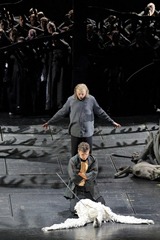| Opera Reviews | 23 April 2024 |
Musical inspiration from Petrenko and the orchestra is the highlight of this Parsifalby Craig A.P. Hamilton |
|
| Wagner: Parsifal Munich Opera Festival June/July 2018 |
|
|
For those interested in philosophy, academia and Jungian concepts this production could offer ample food for thought. Intentionally nothing is what it appears or is normally thought or expected to be. There is no spear, no grail as in chalice etc. it’s all up for grabs and one's own effort in finding a relevant meaning. This includes, for example, the trees folding in on themselves until they are blobs on the stage at the end of Act 1. Or conversely, for all intents and purposes, the inversed scene of Act 1 as the scene for Act III. Or the knights with breasts and men’s dangling parts, the maidens with over proportioned feminine qualities. In fact for the most part the staging comes across as static with very little movement or interaction, with perhaps the overall intention of fulfilling Wagner’s own idea of ‘invisible theatre.’ When there was some movement like in the killing of the swan scene I found it confounding: all the knights rushed on and hid behind two particular trees in particular yet they had the entire forest of trees. Or the majority exiting stage left with a few exiting stage right? Staying with a psychological concept and Jung’s concept of synchronicity when Gurnemanz asks Parsifal if he has understood what he has just seen and then calls him a fool due to his lack of understanding. Sadly I was as clueless as Parsifal. It was at this point that I decided it would be better not to try and fathom what was happening on stage, but to close my eyes instead and simply immerse myself in the wondrous sound thanks to Kirill Petrenko and the sublime cast of singers: Jonas Kaufmann (Parsifal), René Pape (Gurnemanz), Nina Stemme (Kundry), Christian Gerhaher (Amfortas) , Bálint Szabó (Titurel) , Wolfgang Koch (Klingsor). Petrenko’s attention to detail in every bar is exquisitely rendered albeit in an understated, unsentimental, but consistently lyrical, nuanced and clear manner with careful attunement. Dynamics when used were used to optimal effect within each section of orchestral instruments playing with clarity and serenity. The balance at all times between voice to voice, voices to orchestra was as if masterly engineered. The trio in the first act, the flowermaidens scene amongst others were some of the most heavenly sounds I’ve ever heard live. If only for the music the Bayerische Staatsoper orchestra under Kirill Petrenko’s direction is an interpretation not to be missed as it is truly extraordinary.
|
|
| Text ©
Craig A.P. Hamilton Photo © Wilfried Hösl |

 It was only after reading the director and designer's interviews that I was able to gather some semblance of understanding behind the concept for this production. They highlight Parsifal as a mystical, esoteric, symbolic and psychological myth, though the basis of Pierre Audis' production stems first and foremost from the Georg Baselitz' paintings of ‘Heroes’ and a preoccupation with dying and death. So the sets could be seen as more paintings than sets.
It was only after reading the director and designer's interviews that I was able to gather some semblance of understanding behind the concept for this production. They highlight Parsifal as a mystical, esoteric, symbolic and psychological myth, though the basis of Pierre Audis' production stems first and foremost from the Georg Baselitz' paintings of ‘Heroes’ and a preoccupation with dying and death. So the sets could be seen as more paintings than sets. 





